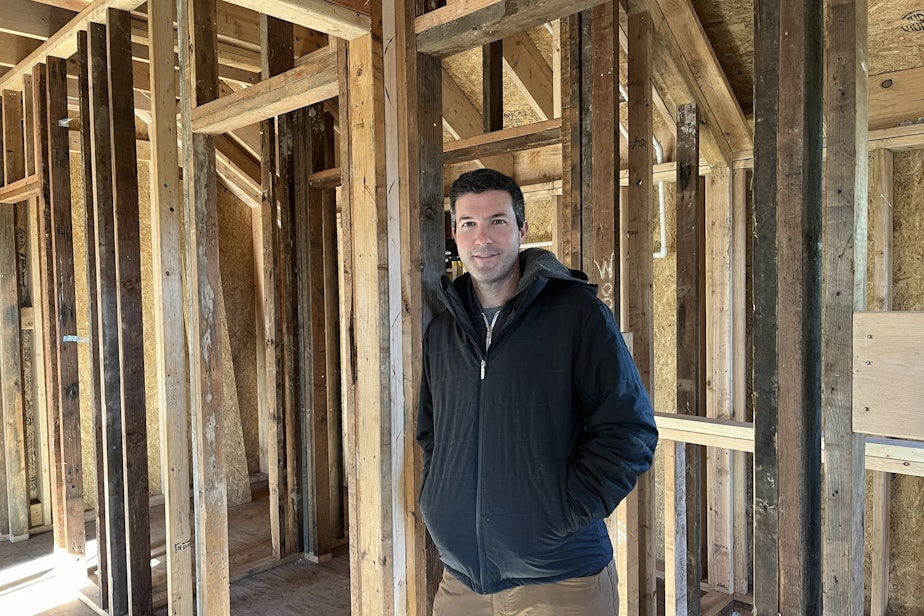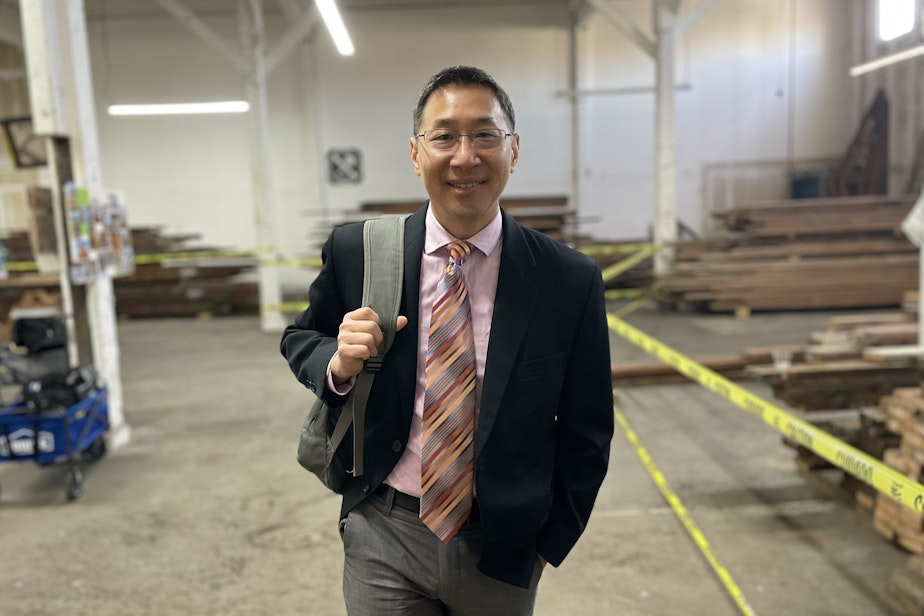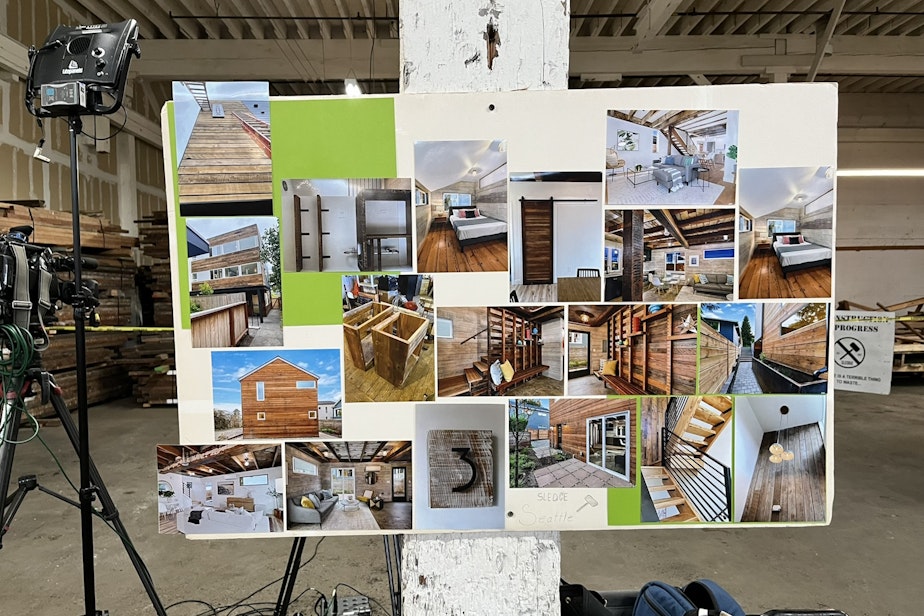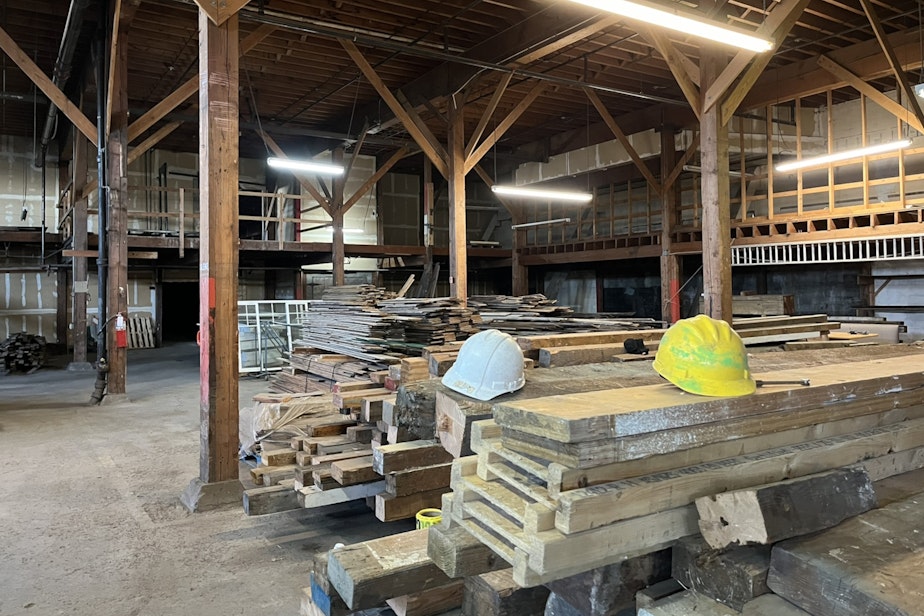'Good bones' from old homes help build Seattle's future

Many of Seattle's single family homes are built from really old wood. Think: Douglas fir trees that stood for 600 years until they were harvested.
When homes are demolished, that wood usually ends up in the dump. But now, a $4 million investment by the Environmental Protection Agency aims to get that old wood into new houses.
O
nly a few, niche builders in the area bother to put recycled wood in their buildings. One of them is Sean Conta, with Targa Homes. He showed off a backyard cottage he's building for a client.
“This is the fourth project we've framed with reclaimed lumber,” he said, gesturing at the exposed stud walls.
You can tell which studs are salvaged. They have a lot more character.

Sponsored
“They're pretty obvious," he said. "Some of them still have paint. A lot of them have nail holes. It's darker wood, but this is great wood. It's functionally as good or better, in my opinion, than new lumber.”
So why don't more contractors use salvaged wood? Because it's easier and cheaper to just knock homes down and throw them away. Deconstructing a home, piece by piece can take five people up to two weeks.
In contrast, demolishing a home the conventional way takes two people with a backhoe a day and a half.
Andrew Lee is the director of Seattle Public Utilities. He was recently at the Fremont transfer station, where members of the public can watch through a big viewing window as contractors dump their loads of construction debris.
“I heard a kid look at the trash and look at his mom and say, 'Mom, some of that stuff doesn't look like waste,'” Lee said.
Sponsored

“And, and that struck me so powerfully, because I think that little kid was right. There's so much that goes into our waste stream right now that can be reused, can be recycled, such as recycled lumber for building materials and things like that.”
Even after you save a bunch of 2x4 studs from a demolished building, they're still not ready for re-use because they're full of nails — and a nail can wreck a saw blade.
Ben Pearson runs a company called Sledge. After hauling salvaged lumber to their warehouse in Ballard, his crew removes all the old nails.
Luckily, they have specialized tools.
Sponsored

“That's a nail pusher," Pearson said as a worker used a tool to drive an old nail through a stud and into a barrel. Across the aisle, another tool grabs the head of a nail and pulls it out. "Sometimes you have to hit it twice. And that's been a great tool we just discovered in the last two years.”
In the end, they have a clean board that can go inside a new wall — or they can mill it, creating new boards prized as a unique finish material.
The old nail holes become part of the charm.
“To me, it's beautiful. I mean, it does not belong in a landfill,” Pearson said.
Sponsored

The $4 million grant from the EPA will pay for a lease on a permanent building for deconstruction companies, along with some new equipment. Ben Pearson of Sledge is interested in the possibility of a nail-pulling robot.

“I think this is going to be an incubation hub," said Casey Sixkiller, the regional director of the EPA. "Cities like Seattle and Portland...are really trying to figure out and establish what the reuse market looks like and what the economics of that are.”
Sponsored
Mayor Bruce Harrell said that aligns with what the city of Seattle aims to do.
"That's why I'm so excited about doing this here in the fastest growing city in the nation," he said. "We are in a constant state of development which, of course, has a significant impact on our environment.”
Two hundred homes are demolished in Seattle each year, on average. That number is set to rise, as the city makes more room for denser forms of housing in neighborhoods currently dominated by older single family homes.
Those neighborhoods have historically enjoyed more protection from development. But recent changes in state law require cities like Seattle to open up these zones, since most cities have repeatedly failed to allow enough housing construction to meet demand.

But just because some of those homes get torn down doesn't mean they can't contribute to the city's future.
“We should consider: What are the impacts of all that additional demolition?" said Katie Kennedy, a waste diversion planner with the city. "And we have an answer...we know how to save the wood from that.”
She said the city has other levers to pull, to encourage wood reclamation. Seattle offers faster permit review for projects that use reclaimed wood. Reclaimed wood is one of several options that can earn builders an extra density bonus.
The city also offers $4,000 to any homeowner who deconstructs, rather than demolishes a building.
At some point, Kennedy said, the city could choose to require building salvage rather than demolition.

Ben Pearson of Sledge said those incentives add up. When he sees an old building slated for demolition, he approaches the contractor and pitches the idea of deconstruction.
Because his company operates on razor thin margins, Pearson said he can't offer them discounts on labor. If they're skeptical, he can offer a hybrid approach, where his crew picks through the wreckage after a building is knocked down. But most importantly, Pearson offers them time by connecting them with expedited city processes.
"I can get your electricity disconnected faster," he tells them.
That's the offer that usually wins them over, he said.
And every day, as more levels of government back the idea of building deconstruction, Pearson has a little more to offer them.
CORRECTION NOTE, 11:30AM, NOVEMBER 20, 2023: The program offering a $4,000 rebate for property owners who deconstruct vs. demolish is paid for by Seattle Public Utilities, and is not funded by the EPA grant. The story has been updated to reflect this.




